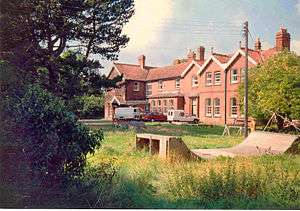Free school movement
| Part of the Politics series on |
| Students rights |
|---|
|
Concepts / Theory
|
|
The free school movement, also known as the new schools or alternative schools movement, was an American education reform movement during the 1960s and early 1970s that sought to change the aims of formal schooling through alternative, independent community schools.
Origins and influences

As disenchantment with social institutions spread with 1960s counterculture, alternative schools sprouted outside the local public school system funded by tuition and philanthropic grants.[1] They were created by parents, teachers, and students in opposition to current practices across the United States and organized without central organization, usually small and grassroots with alternative curricula.[1] Their philosophy is commonly attributed to the counterculture, A. S. Neill and Summerhill, child-centered progressive education of the Progressive Era, the Modern Schools, and Freedom Schools.[1] Influential voices within the movement included Paul Goodman, Edgar Z. Friedenberg, Herb Kohl, Jonathan Kozol, and James Herndon, with titles such as A. S. Neill's 1960 Summerhill, George Dennison's 1969 The Lives of Children, and Jonathan Kozol's 1972 Free Schools.[1] The movement's transference of ideas was tracked through the New Schools Exchange and American Summerhill Society.[1]
The definition and scope of schools self-classified as "free schools" and their associated movement were never clearly delineated, and as such, there was a wide variation between schools.[2] The movement did not cohere around a single ideology, but its "free schools" tended to fall into the binaries of either utopian cultural withdrawal from external concerns, or direct political address of social injustices.[1] Some schools practiced participatory democracies for self-governance.[1] The "free schools" movement was also known as the "new schools" or "alternative schools movement".[2] Author Ron Miller defined the free school movement's principles as letting families choose for their children, and letting children learn at their own pace.[3]
Growth
Allen Graubard charted the growth of the free schools from 25 in 1967 to around 600 in 1972, with estimates of 200 created between 1971 and 1972.[2] These schools had an average enrollment of 33 students.[2] Almost all of the first American free schools were based on Summerhill and its associated book.[4] Many of the schools were started in nontraditional locations, including parks, churches, and abandoned buildings.[3]
The movement peaked in 1972 with hundreds of schools opened and public interest in open education.[3]
Decline and legacy
The movement subsided with the rise of 1970s conservatism,[1] particularly due to the Nixon administration's education policies.[3]
The Huffington Post wrote in 2012 that "the movement is revving up again", citing Education Revolution's listing of over 100 free schools in America.[3] The schools are mostly private in America, and generally serve middle and upper-middle-class families.[3] Author Ron Miller credits the rise of standardization with grassroots interest in alternative schools.[3] CBS News reported in 2006 that the remaining free schools, while unknown in number, are "democratic", as the students share in the school's governance.[5]
Education historian Diane Ravitch said in 2004 that these schools function best for students from educated families due to the free schools' emphasis on individual contribution.[6] Victoria Goldman of The Manhattan Family Guide to Private Schools and Selective Public Schools and E. D. Hirsch, Jr. echoed similar thoughts, with Hirsch adding that "it doesn't work for children who haven't had those advantages."[7] Ravitch believed that the free schools' values would conflict with predominant student testing trends.[6]
Schools still operating
A number of schools founded during the Free school movement period of the late-60s/early-70s are still in operation. These include:
- Sudbury Valley School, Framingham, MA, USA (founded 1968) ("Sudbury School" is a name taken by other schools following the model originating at this school.)
- Albany Free School, Albany, NY, USA (founded 1969)
- Windsor House School, North Vancouver, British Columbia, Canada (founded 1971)
- Linworth Alternative Program, Columbus, OH, USA (founded 1973)
References
- 1 2 3 4 5 6 7 8 Walter, Scott (1999). "Free school movement". In Altenbaugh, Richard J. Historical Dictionary of American Education. Greenwood Publishing Group. p. 145. ISBN 978-0-313-28590-5.
- 1 2 3 4 Graubard 1972c, p. 1.
- 1 2 3 4 5 6 7 Kavner, Lucas (November 30, 2012). "At Brooklyn Free School, A Movement Reborn With Liberty And No Testing For All". The Huffington Post. AOL. Archived from the original on December 7, 2013. Retrieved December 7, 2013.
- ↑ Graubard 1972c, p. 2.
- ↑ Conroy, Scott (November 19, 2006). "No Grades, No Tests At 'Free School'". CBS News. CBS. Associated Press. Archived from the original on December 27, 2013. Retrieved December 27, 2013.
- 1 2 Bahrampour, Tara (February 15, 2004). "NEIGHBORHOOD REPORT: PARK SLOPE; One Man's Solution To the Educational Rat Race". The New York Times. Archived from the original on December 26, 2013. Retrieved December 26, 2013.
- ↑ Gell, Aaron (May 7, 2006). "Land of the Free". The New York Times. Archived from the original on December 7, 2013. Retrieved December 7, 2013.
Sources
- Cremin, Lawrence (1978). "The Free School Movement: A Perspective". In Deal, Terrence E.; Nolan, Robert R. Alternative Schools: Ideologies, Realities, Guidelines. Chicago: Nelson-Hall. pp. 203–210. ISBN 978-0-88229-383-7. Retrieved 28 October 2013.
- Graubard, Allen (1972a). Free the Children: Radical Reform and the Free School Movement. New York: Pantheon Books. ISBN 9780394471327. Retrieved April 27, 2013.
- Graubard, Allen (September 1972c). Alternative Education: The Free School Movement in the United States. Stanford: ERIC Clearinghouse on Media and Technology.
- Hausman, Tate (April 20, 1998). A History of the Free School Movement (PDF) (Thesis). Retrieved April 27, 2013.
- Miller, Ron (2002). Free Schools, Free People: Education and Democracy after the 1960s. Albany: State University of New York Press. ISBN 9780791488249. Retrieved April 27, 2013.
- Kozol, Jonathan (1972). Free Schools. Boston: Houghton Mifflin. ISBN 9780395136065. Retrieved April 27, 2013.
- Schutz, Aaron (2010). Social Class, Social Action, and Education. New York: Palgrave Macmillan. pp. 127–157. ISBN 978-0-230-11357-2.